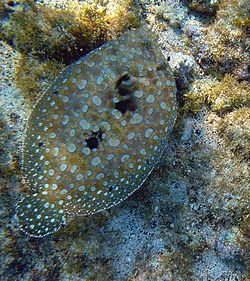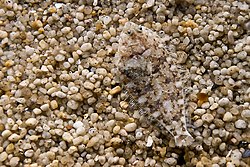| This article needs additional citations for verification. Please help improve this article by adding citations to reliable sources. Unsourced material may be challenged and removed. Find sources: "Flounder" – news · newspapers · books · scholar · JSTOR (February 2012) (Learn how and when to remove this message) |


Bahía de la Chiva, at Hawaii
Flounders are a group of flatfish species. They are demersal fish, found at the bottom of oceans around the world; some species will also enter estuaries.
Taxonomy
The name "flounder" is used for several only distantly related species, though all are in the suborder Pleuronectoidei (families Achiropsettidae, Bothidae, Pleuronectidae, Paralichthyidae, and Samaridae). Some of the better known species that are important in fisheries are:
- Western Atlantic
- Gulf flounder – Paralichthys albigutta
- Southern flounder – Paralichthys lethostigma
- Summer flounder (also known as fluke) – Paralichthys dentatus
- Winter flounder – Pseudopleuronectes americanus
- European waters
- European flounder – Platichthys flesus
- Witch flounder – Glyptocephalus cynoglossus
- North Pacific
- Halibut – Hippoglossus stenolepis
- Olive flounder – Paralichthys olivaceus
Eye migration

Larval flounder are born with one eye on each side of their head, but as they grow from the larval to juvenile stage through metamorphosis, one eye migrates to the other side of the body. As a result, both eyes are then on the side which faces up. The side to which the eyes migrate is dependent on the species type. As an adult, a flounder changes its habits and camouflages itself by lying on the bottom of the ocean floor as protection against predators.
Habitat
Flounders ambush their prey, feeding at soft muddy areas of the sea bottom, near bridge piles, docks, and coral reefs.
A flounder's diet consists mainly of fish spawn, crustaceans, polychaetes and small fish. Flounder typically grow to a length of 22–60 centimeters (8.7–23.6 in), and as large as 95 centimeters (37 in). Their width is about half their length. Male Platichthys have been found up to 130 km (80 mi) off the coast of northern Sardinia, sometimes with heavy encrustations of various species of barnacle.
Fluke, a type of flounder, are being farm raised in open water by Mariculture Technologies in Greenport, New York.
Threats

World stocks of large predatory fish and large ground fish, including sole and flounder, were estimated in 2003 to be only about 10% of pre-industrial levels, largely due to overfishing. Most overfishing is due to the extensive activities of the fishing industry. Current estimates suggest that approximately 30 million flounder (excluding sole) are alive in the world today. In the Gulf of Mexico, along the coast of Texas, research indicates the flounder population could be as low as 15 million due to heavy overfishing and industrial pollution.
References
- Fairchild, E.A.; Howell, W.H (2004). "Factors affecting the post-release survival of cultured juvenile Pseudopleuronectes americanus". Journal of Fish Biology. 65 (Supplementary A): 69–87. Bibcode:2004JFBio..65S..69F. CiteSeerX 10.1.1.532.3120. doi:10.1111/j.0022-1112.2004.00529.x.
- Kreahling, Lorraine (17 November 1996). "Farming Fluke in Open Water". The New York Times. Retrieved 26 July 2017.
- Clover, Charles (2008). The End of the Line: How Overfishing is Changing the World and what We Eat. University of California Press. ISBN 978-0-520-25505-0. OCLC 67383509.
- Myers, R. A.; Worm, B. (2003). "Rapid worldwide depletion of predatory fish communities". Nature. 423 (6937): 280–283. Bibcode:2003Natur.423..280M. doi:10.1038/nature01610. PMID 12748640. S2CID 2392394.
- Dalton, Rex (2006). "Save the big fish: Targeting of larger fish makes populations prone to collapse". BioEd Online. Archived from the original on 27 March 2017. Retrieved 26 March 2017.
- Hsieh, Chih-hao; Reiss, Christian S.; Hunter, John R.; Beddington, John R.; May, Robert M.; Sugihara, George (2006). "Fishing elevates variability in the abundance of exploited species". Nature. 443 (7113): 859–62. Bibcode:2006Natur.443..859H. doi:10.1038/nature05232. PMID 17051218. S2CID 4398663.
- "flounder fish facts". a-z-animals.com.
- "The Flounder Fishery of the Gulf of Mexico, United States: A Regional Management Plan" (PDF). Gulf States Marine Fisheries Commission. October 2000. Number 83.
External links
| Principal commercial fishery species groups | ||||||||||||||||||||
|---|---|---|---|---|---|---|---|---|---|---|---|---|---|---|---|---|---|---|---|---|
| Wild |
|    | ||||||||||||||||||
| Farmed | ||||||||||||||||||||



